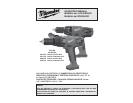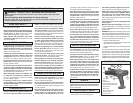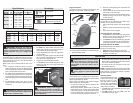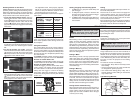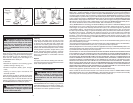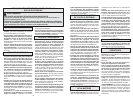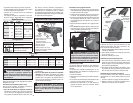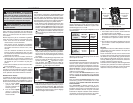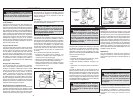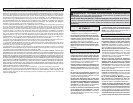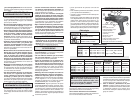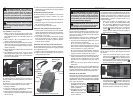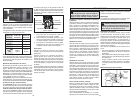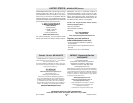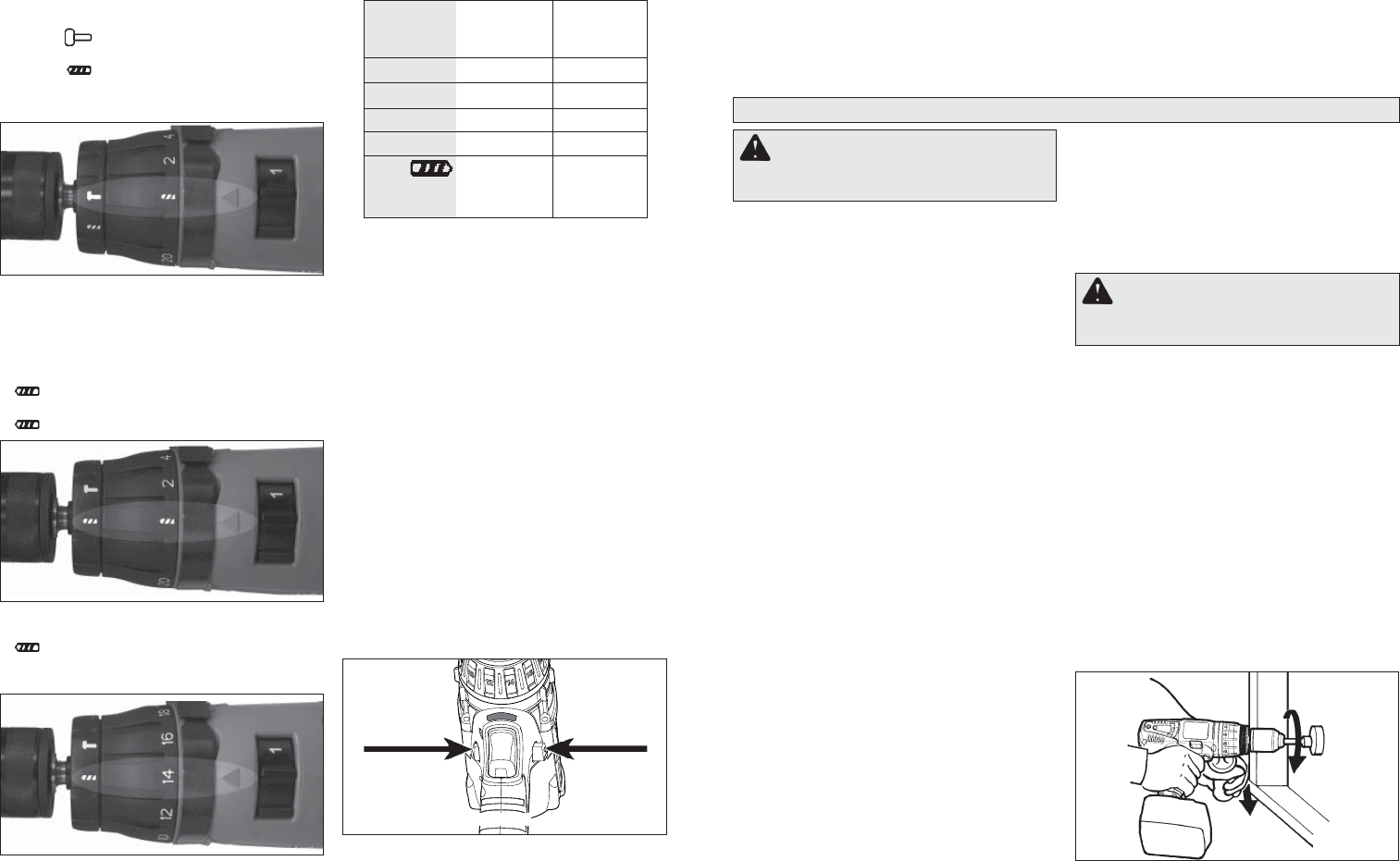
6
7
APPLICATIONS
WARNING To reduce the risk of elec-
tric shock, check work area for hidden pipes
and wires before drilling or driving screws.
Fig. 7
Push for
Forward
Push for
Reverse
PUSH TO CENTER TO LOCK
Fig. 4
To Hammer
Fig. 5
To Drill
Fig. 6
To Drive Screws
Torque
selector
collar setting
1 - 5
6 - 10
11 - 15
16 - 20
Drill
Low
High
0 - 17 in. lbs.
21 - 38 in. lbs.
42 - 60 in. lbs.
65 - 85 in. lbs.
460 in. lbs.
160 in. lbs.
0615-20
& 0617-20
Torque
0 - 17 in. lbs.
21 - 38 in. lbs.
42 - 60 in. lbs.
65 - 85 in. lbs.
495 in. lbs.
175 in. lbs.
0625-20
& 0627-20
Torque
Selecting Hammer or Drill Action
MILWAUKEE Hammer-Drills are designed for three
operating modes: drilling with hammering action,
drilling only, and driving screws. To set the operating
mode, rotate the hammer/drill selector collar and
torque selector collar to the desired symbols.
1. To use the hammer-drilling mode, rotate the
hammer/drill selector collar until the hammer
symbol
appears in line with the arrow. Then
rotate the Torque selector collar until the drill
symbol appears in line with the arrow. Ap-
ply pressure to the bit to engage the hammering
mechanism.
NOTE: When using carbide bits, do not use water
to settle dust. Do not attempt to drill through steel
reinforcing rods. This will damage the carbide
bits.
2. To use the drilling only mode, rotate the
hammer/drill selector collar until the drill symbol
appears in line with the arrow. Then rotate
the Torque selector collar until the drill symbol
appears in line with the arrow.
3. To use the driving screws mode, rotate the
hammer/drill selector collar until the drill symbol
appears in line with the arrow. Then rotate
the torque selector collar until the desired clutch
setting appears in line with the arrow.
The adjustable clutch ,when properly adjusted,
will slip at a preset torque to prevent driving the
screw too deep into different materials and to
prevent damage to the screw or tool.
The torque specifi cations shown here are approxi-
mate values.
NOTE: Because the above settings are only a
guide, use a piece of scrap material to test the dif-
ferent clutch positions before driving screws into
the workpiece.
Using Control Switch
The control switch may be set to three positions:
forward, reverse and lock. Due to a lockout mecha-
nism, the control switch can only be adjusted when
the ON/OFF switch is not depressed. Always allow
the motor to come to a complete stop before using
the control switch.
For forward (clockwise) rotation, push in the control
switch from the right side of the tool. Check the
direction of rotation before use.
For reverse (counterclockwise) rotation, push in the
control switch from the left side of the tool. Check
direction of rotation before use.
To lock the trigger, push the control switch to the
center position. The trigger will not work while
the control switch is in the center locked position.
Always lock the trigger or remove the battery
pack before performing maintenance, changing
accessories, storing the tool and any time the tool
is not in use.
Starting, Stopping and Controlling Speed
1. To start the tool, grasp the handle fi rmly and
pull the trigger.
2. To vary the speed, increase or decrease the
pressure on the trigger. The further the trigger
is pulled, the greater the speed.
3. To stop the tool, release the trigger. Make sure
the bit comes to a complete stop before laying
the tool down.
Drilling
Set both the hammer/drill and torque selector col-
lars to the drill positions.
Place the bit on the work surface and apply fi rm
pressure before starting. Too much pressure will
slow the bit and reduce drilling effi ciency. Too little
pressure will cause the bit to slide over the work
area and dull the point of the bit.
If the tool begins to stall, reduce pressure slightly to
allow the bit to regain speed. If the bit binds, reverse
the motor to free the bit from the workpiece.
Drilling in Wood, Composition Materials and
Plastic
When drilling in wood, composition materials and
plastic, start the drill slowly, gradually increasing
speed as you drill. When drilling into wood, use
wood augers or twist drill bits. Always use sharp
bits. When using twist drill bits, pull the bit out of the
hole frequently to clear chips from the bit fl utes. To
reduce the chance of splintering, back work with a
piece of scrap wood. Select low speeds for plastics
with a low melting point.
Drilling in Metal
When drilling in metal, use high speed steel twist
drills or hole saws. Use a center punch to start the
hole. Lubricate drill bits with cutting oil when drilling
in iron or steel. Use a coolant when drilling in non-
ferrous metals such as copper, brass or aluminum.
Back the material to prevent binding and distortion
on breakthrough.
Drilling in Masonry
When drilling in masonry, select the hammer-drill
operating mode (hammer-drills only). Use high
speed carbide-tipped bits. Drilling soft masonry ma-
terials such as cinder block requires little pressure.
Hard materials like concrete require more pressure.
A smooth, even fl ow of dust indicates the proper
drilling rate. Do not let the bit spin in the hole without
cutting. Do not use water to settle dust or to cool
bit. Both actions will damage the carbide.
Driving Screws and Nut Running
Drill a pilot hole when driving screws into thick or
hard materials. Set the torque selector collar to the
proper position and set the speed to low. Use the
proper style and size screwdriver bit for the type
of screw you are using.
With the screwdriver bit in the screw, place the tip of
the screw on the workpiece and apply fi rm pressure
before pulling the trigger. Screws can be removed
by reversing the motor.
Overloading
Continuous overloading may cause permanent
damage to tool or battery pack.
Fig. 8
Reaction
Forward
rotation
Bracing
against the
fl oor
WARNING High rotational force. To
reduce the risk of injury, always hold or brace
securely. Always use side handle on tools.
Bit Binding
A high rotational force occurs when a bit binds. If
the bit binds, the tool will be forced in the opposite
direction of the bit rotation. Bits may bind if they
are misaligned or when they are breaking through
a hole. Wood boring bits can also bind if they run
into nails or knots. Be prepared for bit binding
situations.
To reduce the chance of bit binding:
• Use sharp bits. Sharp bits are less likely to bind
when drilling.
• Use the proper bit for the job. There are bits that
are designed for specifi c purposes.
• Use caution when drilling pitchy, knotty, wet or
warped material or when drilling in material that
may contain nails.
Typical Bracing Methods



